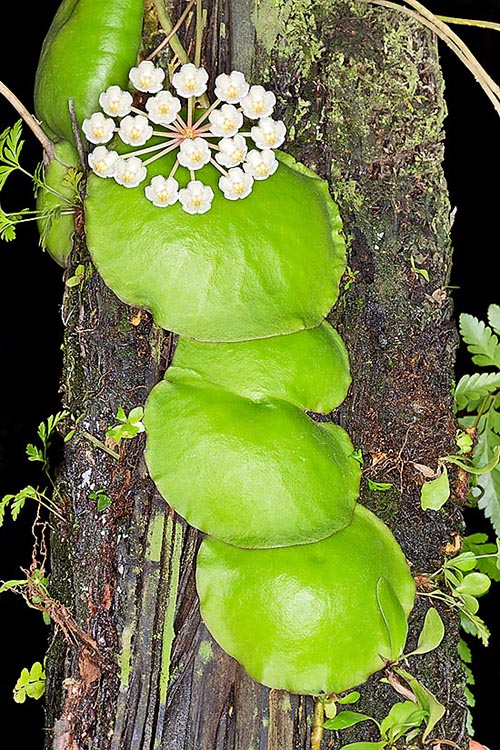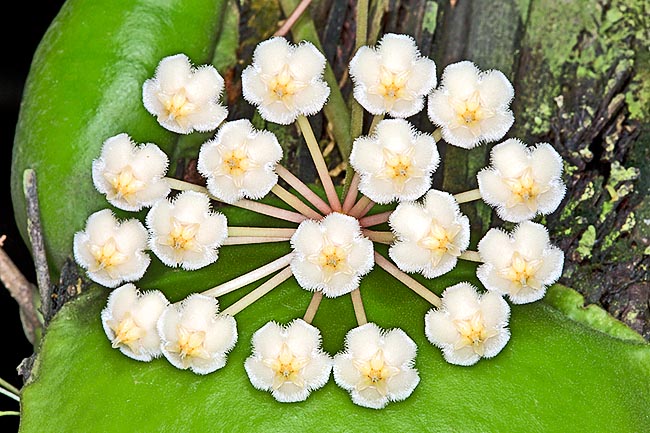Family : Apocynaceae

Text © Pietro Puccio

English translation by Mario Beltramini

The Hoya imbricata is a Philippines species characterized by leaves overlapped like tiles. This unusual species grows on the trunk of trees in symbiosis with colonies of small ants to whom it offers, in return, shelter between the foliar interstices © G. Mazza
The species is native to Philippines where it grows on the trunks of the trees of the humid forests at low and medium altitudes.
The genus is honoured to Thomas Hoy (ca. 1750-1822), botanist and curator of the gardens of the duke of Northumberland; the name of the species is the Latin adjective “imbricatus, a, um” = imbricate, overlapped like tiles, with reference to the disposition of the leaves.
Common names: paui-pauikan (Tagalog).
The Hoya imbricata Decne. (1844) is an evergreen climber with rooting stems, up to 3 m long, with only one leaf, on short petiole, per node; it is not clear if this is due to the failure to grow of one of the two or to the fusion of both.
The leaves are orbicular, of 7-12 cm of diameter, imbricate, convex, coriaceous, of pale green colour above, suffused of purple below, with the margins strictly adhering to the trunk on which the plant climbs; there are varieties with marbled leaves.
In the cavity under each leaf develop from the stem many roots serving to anchor the plant and to absorb the humidity.
Axillary umbellate inflorescences, on about 10 cm long peduncle, bearing numerous flowers with corolla of 0,8-1 cm of diameter of cream white colour, with 5 triangular lobes with pointed retroflexed apex, externally glabrous, internally covered by a thick and short hairiness.
The fruits are fusiform follicles containing numerous thin seeds, about 0,8 cm long, of brown colour, provided of a tuft of silky hairs, about 1,2 cm long, which favour their dispersion through the wind.
It reproduces by seed in draining loam rich of organic substance maintained humid, but usually by cutting, with portions of stem provided of 2-3 nodes, utilizing a loam formed per the 50% by coarse siliceous sand or agri-perlite, maintained humid at the temperature of 24-26 °C.
Myrmecophile species (which lives in symbiosis with the ants), in fact the cavity formed by the leaves, besides protecting the roots and creating them a humid microhabitat, offer shelter to colonies of small ants who, in turn, furnish nourishments for the growth of the plant.

The umbellate inflorescences carry numerous 8-10 mm flowers. Unusual, rare and difficult to cultivate © G. Mazza
It needs a suitable rigid support, like pieces of bark or big branches, where the leaves can adhere, otherwise they wrap around themselves.
The waterings must be regular in summer, more spaced in winter, but without allowing the substratum to dry up completely, with frequent nebuli- sations in presence of dry air, using water at ambient temperature non calcareous, rainwater, demineralised on from reverse osmosis, also to avoid unaesthetic deposits on the leaves.
→ To appreciate the biodiversity within the APOCYNACEAE family please click here.
